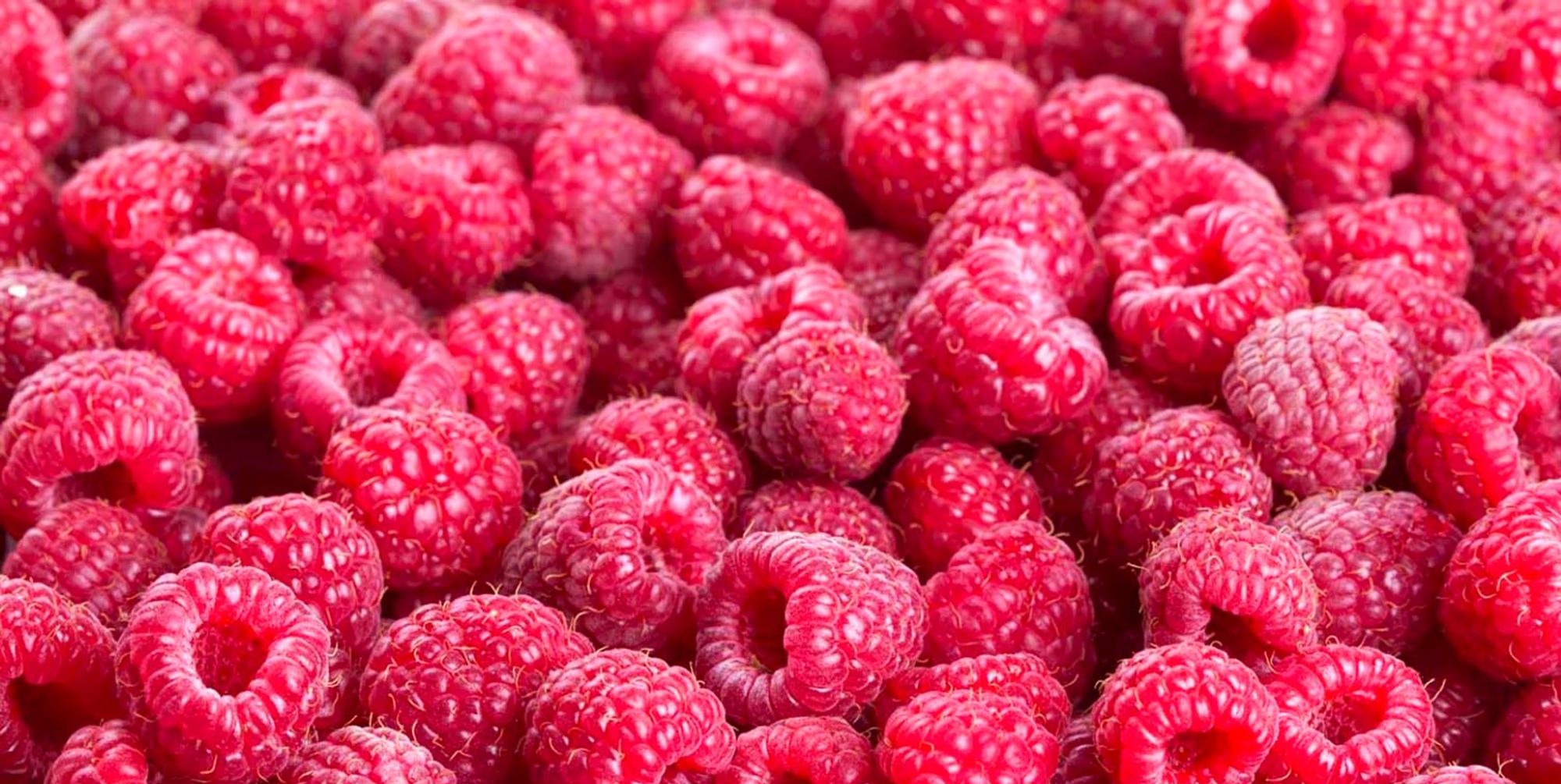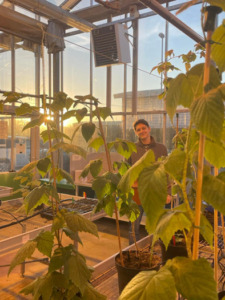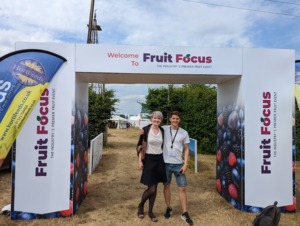A year at Cranfield
09/05/2023

The start of April 2023 marked a year since I began my PhD in plant molecular biology at Cranfield. My project focuses on bringing academic research into a commercial setting, which, as an applied scientist, was highly appealing to me. Specifically, I’m developing a gene editing method in raspberries which would dramatically accelerate breeding, and hopefully make growing the crop more sustainable through improving disease resistance, reducing waste and requiring fewer chemical inputs. Nobody has ever gene edited a raspberry before (or at least hasn’t published it), which is quite surprising because nearly 900,000 tonnes of them are sold every year, with a combined import/export value of $6.6 billion dollars per annum.
 Figure 1: Raspberry plants (and me) enjoying the late evening sunshine in the Cranfield glasshouse.
Figure 1: Raspberry plants (and me) enjoying the late evening sunshine in the Cranfield glasshouse.
You may ask: ‘why would anyone with a sane mind spend four years of their life researching a relatively minor fruit crop?’, which remains a valid question, although for me the crop species is secondary to developing expertise in one of the most consequential developments in molecular biology this century – gene editing with CRISPR-Cas9. This technology allows scientists like me to make tiny, highly precise changes in practically any species’ DNA, which is incredibly useful for many, many, many things. A simple theoretical example would be an edit that increases the production of a structural protein found in raspberry fruit walls, meaning the fruit doesn’t burst as easily, meaning fungi like Botrytis cinerea (grey mould – like you find on all kinds of fruit) can’t take hold and ruin your summer picnics. This would save millions of pounds for growers, bring down prices for consumers and reduce the carbon footprint of the industry.
Anyhow, I knew I wanted to work on gene editing, and I’m interested in making agriculture more sustainable (agriculture is responsible for 21% of global greenhouse gas emissions, more than all planes, trains and cars combined), so the two pair together well in the plant sciences. When I searched ‘plant gene editing PhDs’, one at Cranfield popped up and it was a perfect fit. I quit my job in the Civil Service and headed to Bedfordshire.
I threw myself into my PhD at Cranfield from the moment it started as it finally felt like I had a trajectory again, which was a great feeling. Cranfield was a very different experience from previous Universities I’d studied at, with a much more remote campus and no undergraduates getting stuck underfoot. There are many dualities, such as a lack of undergrads meaning you get a lot more focus from your supervisors, but the campus itself is much quieter, without a raucous student union. Traffic cones, for the most part, remain unharmed.
It was a good balance for me, as it was still a lot more sociable than a workplace office, and I made friends quickly. PhD life requires many hours spent working alone, so you need people to chat to at lunch. I was also lucky, as I got positive results relatively soon after joining (most people will wait at least a year before they’re up and running), which in part is due to the nature of my project requiring short experiments repeated many times, and part due to the fact that barely anybody conducts molecular research on raspberries. I also worked quite hard. There are few better feelings in the world than getting positive results that are entirely down to your own hard work.

Figure 2: Single raspberry cells marked with a fluorescent viability stain. Each cell can be gene edited in this state and go on (theoretically) to grow into a new, enhanced raspberry plant.
I’ve also worked closely with our industrial sponsor, which is an invaluable experience that Cranfield really does facilitate more than most universities, by offering projects with significant commercial applications.
Getting their perspective on my research as I conduct it is imperative to ensure I stay focused on the issues I’m trying to solve, and most importantly, to ensure that my research does not just sit on a shelf (where many PhDs/research live and die) and is utilised in the real world. I’ve had the chance to go to three events/conferences so far, which are another fundamental part of doing a PhD – I cannot overstate the importance of networking – and they have all been useful experiences that help you put your own work into perspective and are an excellent chance to travel around a bit.

Figure 3: Fruit Focus 2022, an industry-focused event for fruit growers and academics.
I had absolutely no prior experience of the techniques I have used (just theoretical knowledge), and nobody else at Cranfield had used these techniques either, yet the amount of experience I have gained in my field in just one year is huge. I’m hopeful this will enable me, in another three years time, to take the next step in my career, be it remaining within academia or going commercial. I have no regrets about leaving my career and starting a PhD, it was the right decision for me. It’s scary to think I’ll be nearly 28 when I finish but I think deep down I always wanted to do a PhD, and so far, I’ve been enjoying studying at Cranfield.
Categories & Tags:
Leave a comment on this post:
You might also like…
Preparing your work for Turnitin submission
Before submitting your work into Turnitin for similarity checking, if you have used referencing software then you may need to take some important steps first. Mendeley and Zotero integrate with MS Word by embedding field ...
The fast track to supercar engineering: My Cranfield journey
It’s been a dream come true to work on some of the world’s most prestigious supercars – the Aston Martin Valhalla, McLaren 750 & Artura, the GMA T.33. But every successful ...
Automotive Engineering: From student to hypercar innovation at Rimac
We sat down with recent graduate Thomas Perrin, to discuss how his year on the MSc in Automotive Engineering at Cranfield University propelled him from the lecture hall directly into the ...
What this year at Cranfield really meant to me
Every Cranfield journey is unique. In this alumni reflection, Zachea Scicluna shares what her year at Cranfield truly meant, from facing uncertainty to gaining hands-on experience in industry-backed projects. I’ve been reflecting (and delaying) ...
Preparing for assignments and exams?
Sorry! We know it seems a bit mean to mention the exams in January rather than looking forward to the break before it! However, we know many of you will be thinking about your forthcoming ...
Screening for FTSE 100 companies on Bloomberg
So you’re researching an index and need some data on its constituent companies? Bloomberg’s Equity Screening tool makes light work of this, not just for the FTSE, but for indices, exchanges and sectors worldwide. Type EQS ...







